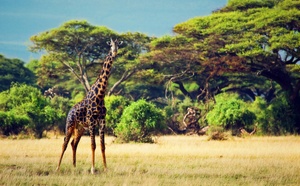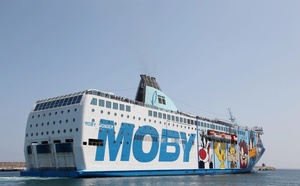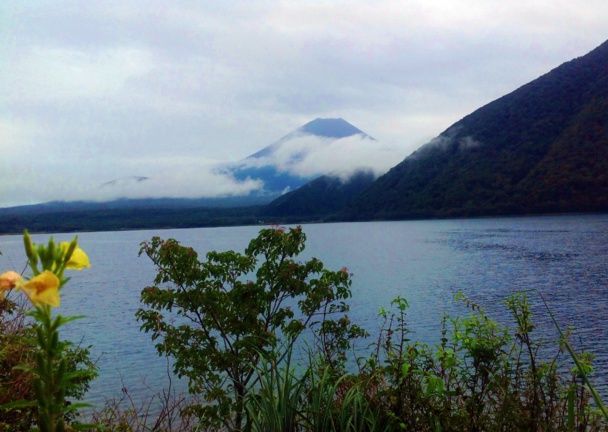
The Fuji Yama, listed as a UNESCO heritage site, culminates at 3,776 meters. /photo JDL
Of course Tokyo and Kyoto are two unmissable steps when visiting Japan, but one should not summarize the Empire of the Rising Sun to just these two cities.
Which is why, without having to suffer hundreds of kilometers, it is completely possible, through an organized tour or individual trip, to spice up your visit with a few strategic detours.
You’ve had enough of the kabukis, the runkari and its puppets, the Nô theater, floral art, erratic acrobatics to avoid the small electric cars at the Tsukji (1) fish market that run into you without warning?
Then let’s head to less bustling areas, sure, but that are nonetheless full of Japanese spirit, mysticism, and values.
It is completely possible to be entertained for 3, 4 days in the 5 lakes region, in the Fuji-Hakone-Izu Park (2).
Far (but not too much) from the urban setting and the skyscrapers of the capital, here are some more rural landscapes for nature-lovers, between large water bodies, mountains, Japanese gardens, sanctuaries, and cable-cars that enable to take in, through only one look, vast stretches of land that offer an unforgettable view.
Which is why, without having to suffer hundreds of kilometers, it is completely possible, through an organized tour or individual trip, to spice up your visit with a few strategic detours.
You’ve had enough of the kabukis, the runkari and its puppets, the Nô theater, floral art, erratic acrobatics to avoid the small electric cars at the Tsukji (1) fish market that run into you without warning?
Then let’s head to less bustling areas, sure, but that are nonetheless full of Japanese spirit, mysticism, and values.
It is completely possible to be entertained for 3, 4 days in the 5 lakes region, in the Fuji-Hakone-Izu Park (2).
Far (but not too much) from the urban setting and the skyscrapers of the capital, here are some more rural landscapes for nature-lovers, between large water bodies, mountains, Japanese gardens, sanctuaries, and cable-cars that enable to take in, through only one look, vast stretches of land that offer an unforgettable view.
Listed as a UNESCO site, the Mount Fuji culminates at 3,776 m
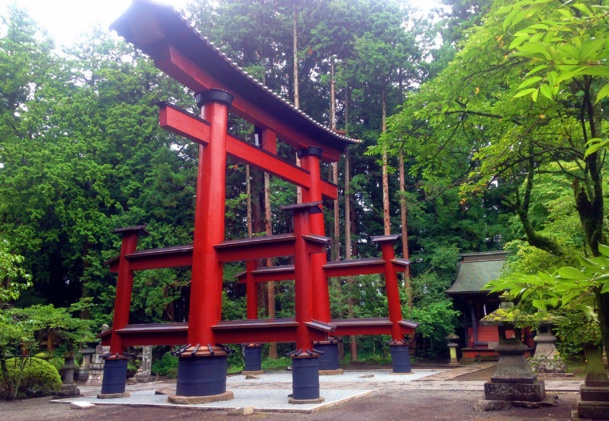
One of Asia’s most important arches, established at the foot of Mount Fuji /photo JDL
Our visit begins with a short tour of the lakes, in the enchanting region of the Fuji.
Some of them are of volcanic origin, and while it is difficult to swim due to the strong current, one can still fish or take a boat tour.
This region is filled with legends, ferocious dragons who eat little kids, and fearless monks.
Now, time to head to Mount Fuji. Listed as a UNESCO heritage site and located at one hundred kilometers from Tokyo, this symbol of Japanese spirituality culminates at 3,776 meters.
But before starting its ascent, a stop at the Pilgrims’ Traditional House (Oshi) is mandatory.
Two monuments still stand, also listed at heritage sites, but they only open their doors in July and August, during the high season.
It is here that visitors would stay and pray before heading to the peak.
The Mount Fuji is not only a site of devotion, but of festivities as well.
Out of the three fireworks festivals that take place in the country, the one at Fuji, in August, is the most popular and attracts close to 170,000 people every year.
Chants, dances, and fire columns are lit up in the streets to honor the Gods.
Purposely set up for the event, the site managed by the kakugyou monks is impressive with its row of cedars that are over 300 years old, and its monumental arche, one of Asia’s largest.
Lions sculpted in dark lava stone adorn the initiatory path that invites travelers to walk towards the top.
But it must be done the right way: pilgrims have to redeem themselves and first put on a white robe (that of death) to climb up, die spiritually to then be symbolically reborn.
Some of them are of volcanic origin, and while it is difficult to swim due to the strong current, one can still fish or take a boat tour.
This region is filled with legends, ferocious dragons who eat little kids, and fearless monks.
Now, time to head to Mount Fuji. Listed as a UNESCO heritage site and located at one hundred kilometers from Tokyo, this symbol of Japanese spirituality culminates at 3,776 meters.
But before starting its ascent, a stop at the Pilgrims’ Traditional House (Oshi) is mandatory.
Two monuments still stand, also listed at heritage sites, but they only open their doors in July and August, during the high season.
It is here that visitors would stay and pray before heading to the peak.
The Mount Fuji is not only a site of devotion, but of festivities as well.
Out of the three fireworks festivals that take place in the country, the one at Fuji, in August, is the most popular and attracts close to 170,000 people every year.
Chants, dances, and fire columns are lit up in the streets to honor the Gods.
Purposely set up for the event, the site managed by the kakugyou monks is impressive with its row of cedars that are over 300 years old, and its monumental arche, one of Asia’s largest.
Lions sculpted in dark lava stone adorn the initiatory path that invites travelers to walk towards the top.
But it must be done the right way: pilgrims have to redeem themselves and first put on a white robe (that of death) to climb up, die spiritually to then be symbolically reborn.
Ôyama eki and its shintô temple, Ôyama Afuri Jinja
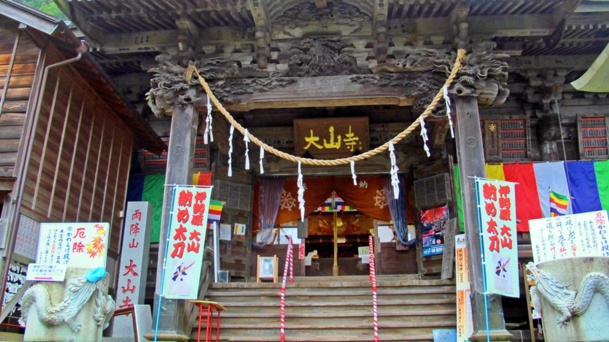
The Shintô temple, Ôyama Afuri Jinja /photo JDL
Every year, during the two months of opening (July and August), 2 to 3 million people flock to Fuji and, 300,000 of them attempt the ascent.
After the first step, (accessible by car) at 2,305 meters (5th station), it takes 5 hours to climb to the top.
Depending on the time of year and weather, the Fuji Yama can hide behind a thick layer of clouds or pierce with its spectacular white top, that looks like a spear, the stratocumulus…
If you missed this slot, then head to the Kachi Kachi cable railway. Here, there is an incredible panoramic view of the lake and resort ,of the same name, along with a beautiful lookout area on the mountain.
As a plus, and depending on the season (Fall), the woods at the bottom come alive with vibrant shades of red, yellow, and auburn offering the most wonderful spectacle to the eyes and other senses.
Another ascent, and other point of interest in the Kanagawa region: the Ôyama eki and its shintô temple, Ôyama Afuri Jinja.
The mount rises to 1,252 meters, and the temple is located at around 700 m.
One can reach it through a cable railway (Oyma Cable.) Both niched in the lush green landscape, they seem to drown in the fine mist and mysterious fog of this very rainy region.
Japanese people come here to celebrate the New Year and sometimes for baptisms or family ceremonies.
Close to one million visitors climb it every year. Two paths separate men and women.
During the ceremony, the priest kneels down in front of the altar and blesses the worshippers during the very popular purification ceremony, while the gong resonates solemnly.
After the first step, (accessible by car) at 2,305 meters (5th station), it takes 5 hours to climb to the top.
Depending on the time of year and weather, the Fuji Yama can hide behind a thick layer of clouds or pierce with its spectacular white top, that looks like a spear, the stratocumulus…
If you missed this slot, then head to the Kachi Kachi cable railway. Here, there is an incredible panoramic view of the lake and resort ,of the same name, along with a beautiful lookout area on the mountain.
As a plus, and depending on the season (Fall), the woods at the bottom come alive with vibrant shades of red, yellow, and auburn offering the most wonderful spectacle to the eyes and other senses.
Another ascent, and other point of interest in the Kanagawa region: the Ôyama eki and its shintô temple, Ôyama Afuri Jinja.
The mount rises to 1,252 meters, and the temple is located at around 700 m.
One can reach it through a cable railway (Oyma Cable.) Both niched in the lush green landscape, they seem to drown in the fine mist and mysterious fog of this very rainy region.
Japanese people come here to celebrate the New Year and sometimes for baptisms or family ceremonies.
Close to one million visitors climb it every year. Two paths separate men and women.
During the ceremony, the priest kneels down in front of the altar and blesses the worshippers during the very popular purification ceremony, while the gong resonates solemnly.
Hakone: an open-air museum that is full of life…
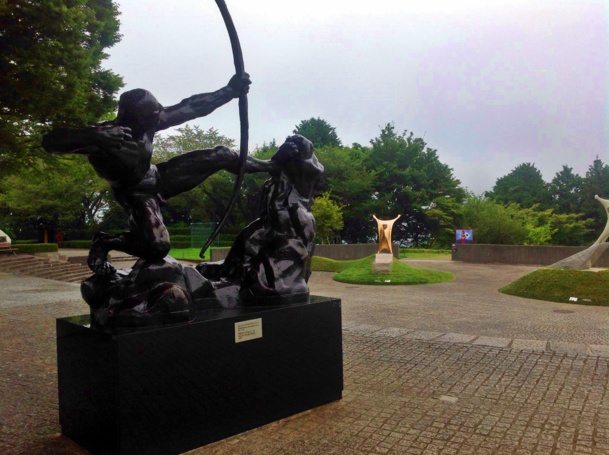
One hundred sculptures, contemporaries of Japanese and Western artist, spread out over an area of 70,000 m2. /photo JDL
The worshippers then place the branch with the stem looking towards the altar. And at the end of the ceremony, the priest offers them saké in a small cup.
If you’re looking for authenticity, then head towards the Aihara family restaurant, an unmissable stop in the region. It was created in 1600 and the representative of the 18th generation of this honorable establishment welcomes you in person. Respect!
Not far away, one cannot miss the Hakone Open Air Museum, located just one hundred kilometers from Tokyo.
Daily, regular transfers by train facilitate a quick escapade from the capital.
This open air museum, in a splendid landscaped park, was created by a press tycoon and inaugurated in 1969. One hundred sculptures, contemporaries of Japanese and Western artist, expand over an area of 70,000 m2.
Also worth noting: the remarkable Picasso pavilion that was added to the museum in 1984 and that now hosts a collection of 300 pieces by the artist along with Henry Moore collection (36 pieces), one of the world’s largest. 50,000 visitors rush there every year, of which 80% are Japanese.
If you’re looking for authenticity, then head towards the Aihara family restaurant, an unmissable stop in the region. It was created in 1600 and the representative of the 18th generation of this honorable establishment welcomes you in person. Respect!
Not far away, one cannot miss the Hakone Open Air Museum, located just one hundred kilometers from Tokyo.
Daily, regular transfers by train facilitate a quick escapade from the capital.
This open air museum, in a splendid landscaped park, was created by a press tycoon and inaugurated in 1969. One hundred sculptures, contemporaries of Japanese and Western artist, expand over an area of 70,000 m2.
Also worth noting: the remarkable Picasso pavilion that was added to the museum in 1984 and that now hosts a collection of 300 pieces by the artist along with Henry Moore collection (36 pieces), one of the world’s largest. 50,000 visitors rush there every year, of which 80% are Japanese.
Gora Park, a garden "à la française”...
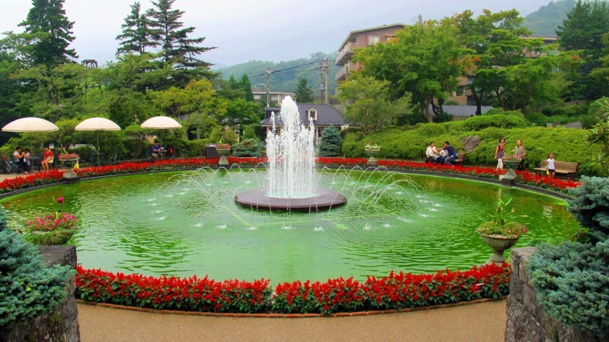
In this “French-style” garden, the monumental fountain is one of the main attractions/ photo JDL
The Gora Park is also located in Halkone just a few steps from the open-air museum.
In this “à la française” garden, of which the monumental fountain makes up one of the main attractions, families can participate in various manual activities, like visiting the botanical garden or be initiated to the tea ceremony.
There are two versions: the touristic (550 yens, around 4 euros) rushed through in 10 minutes, and the “authentic” version, that can last an entire day during special events, just like a traditional ceremony.
A woman dressed in a geisha kimono presents the tea to you and then makes a reverence. You must return the salute and turn the tea cup in its plate by a quarter turn and take a loud sip to demonstrate that you enjoy the drink.
This is Japan: a mixture of tradition and modernity both perfectly integrated and celebrated. An explosive cocktail that proves that it can be the world’s 4th strongest economy without having to deny what constitutes the essence of Japanese civilization.
In this “à la française” garden, of which the monumental fountain makes up one of the main attractions, families can participate in various manual activities, like visiting the botanical garden or be initiated to the tea ceremony.
There are two versions: the touristic (550 yens, around 4 euros) rushed through in 10 minutes, and the “authentic” version, that can last an entire day during special events, just like a traditional ceremony.
A woman dressed in a geisha kimono presents the tea to you and then makes a reverence. You must return the salute and turn the tea cup in its plate by a quarter turn and take a loud sip to demonstrate that you enjoy the drink.
This is Japan: a mixture of tradition and modernity both perfectly integrated and celebrated. An explosive cocktail that proves that it can be the world’s 4th strongest economy without having to deny what constitutes the essence of Japanese civilization.
Region of the tour
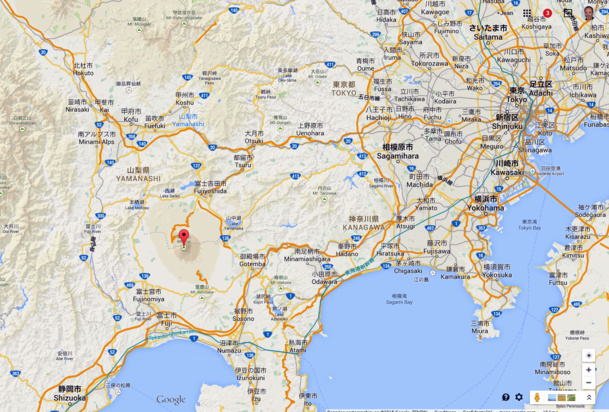
Click to enlarge map
(1) Tsukiji, the world’s largest fish market, a major touristic attraction in Tokyo, should close its doors to the public in 2015 and be moved elsewhere due to its state of dilapidation.
This emblematic spot, built in the last century, does not meet the required safety norms anymore. A great reason to incite your clients to visit it as soon as possible.
(2) The Fuji-Hakone-Izu National Park, is a Japanese National Park in the prefectures of Yamanashi, Shizuoka, Kanagawa and Tokyo. The park includes Mount Fuji, the five Fuji lakes, Hakone, the Izu peninsula, and the Izu archipelago.
(3) Hakone Open Air Museum
This emblematic spot, built in the last century, does not meet the required safety norms anymore. A great reason to incite your clients to visit it as soon as possible.
(2) The Fuji-Hakone-Izu National Park, is a Japanese National Park in the prefectures of Yamanashi, Shizuoka, Kanagawa and Tokyo. The park includes Mount Fuji, the five Fuji lakes, Hakone, the Izu peninsula, and the Izu archipelago.
(3) Hakone Open Air Museum
Practical Information
Flights (main companies)
- Japan Airlines
- ANA
- Air France
Guides
Guide Evasion Tokyo, Kyoto, Osaka, Guide Japon de National Geographic, Lonely Planet, (2010) Guide du Routard
Weather
Weather in the Japanese archipelago varies from continental to subtropical. In Hokkaido, Winters are long, snowy, and very rough; whereas in Okinawa the temperature never drops below 15°C.
The most touristic regions on the Honshu island, such as Tokyo and Kyoto, have relatively warm Winters with little snow, with hot and humid Summers. Seasons vary greatly.
- Japan Airlines
- ANA
- Air France
Guides
Guide Evasion Tokyo, Kyoto, Osaka, Guide Japon de National Geographic, Lonely Planet, (2010) Guide du Routard
Weather
Weather in the Japanese archipelago varies from continental to subtropical. In Hokkaido, Winters are long, snowy, and very rough; whereas in Okinawa the temperature never drops below 15°C.
The most touristic regions on the Honshu island, such as Tokyo and Kyoto, have relatively warm Winters with little snow, with hot and humid Summers. Seasons vary greatly.










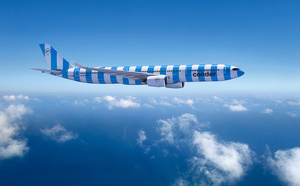


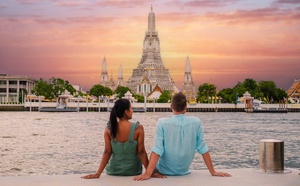
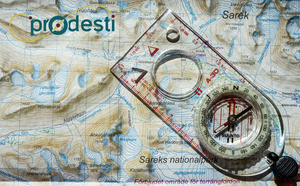




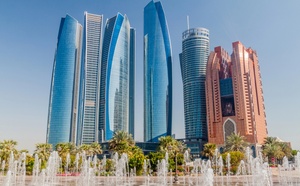

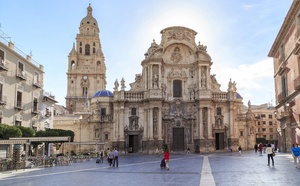




![Tourisme : où sont passés les Chinois ? [ABO] Tourisme : où sont passés les Chinois ? [ABO]](https://www.tourmag.com/photo/art/large_16_9/87929923-62307593.jpg?v=1744721842)
